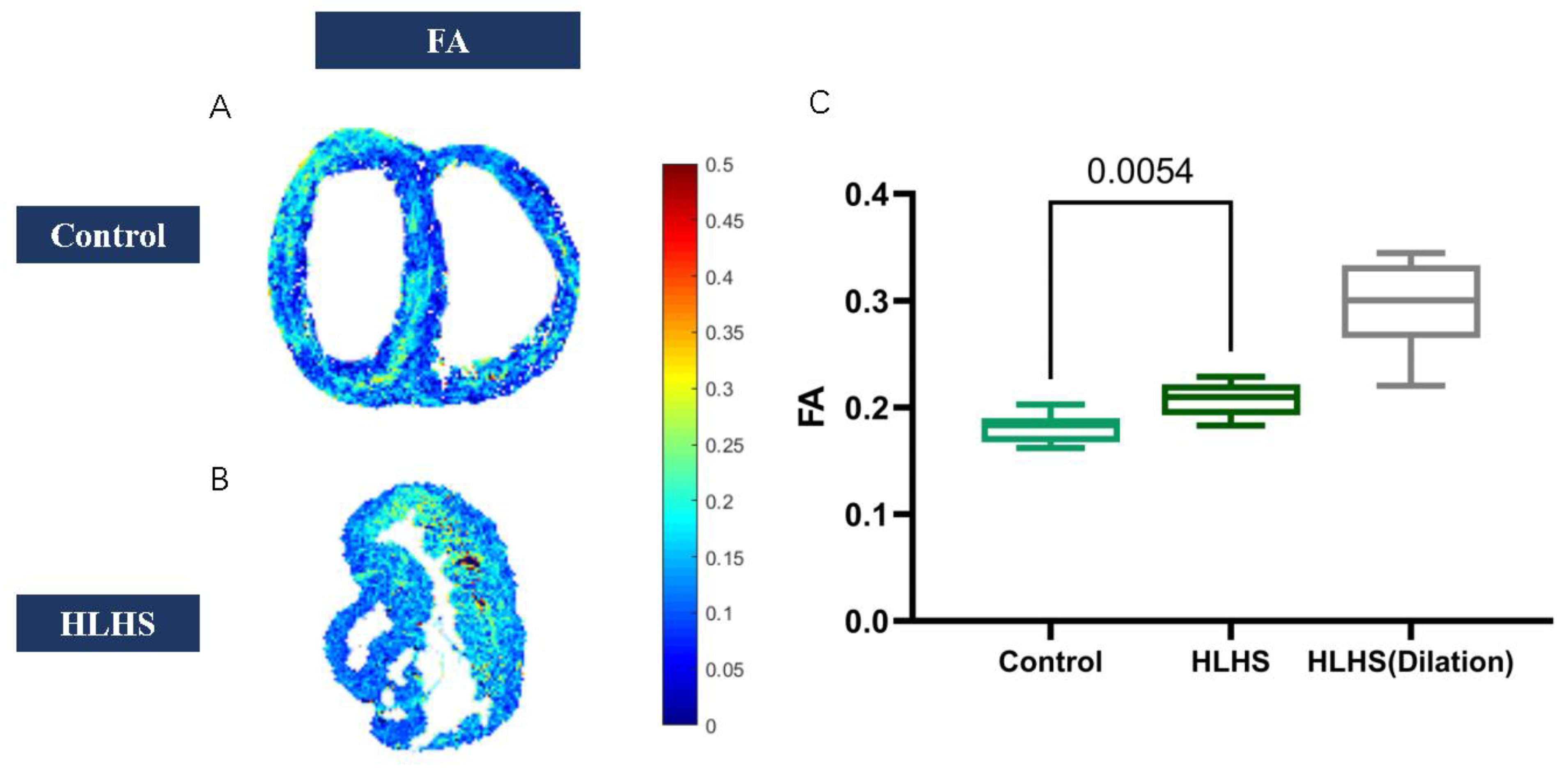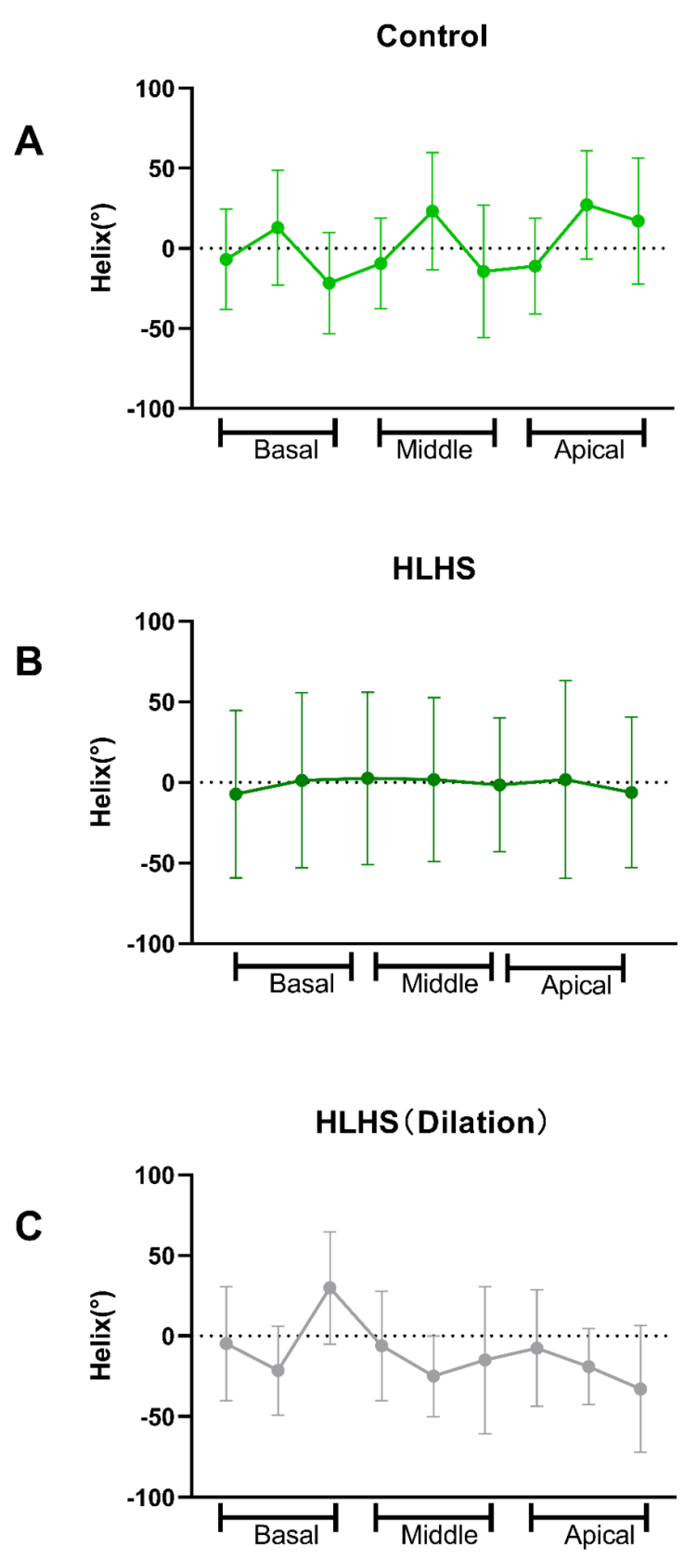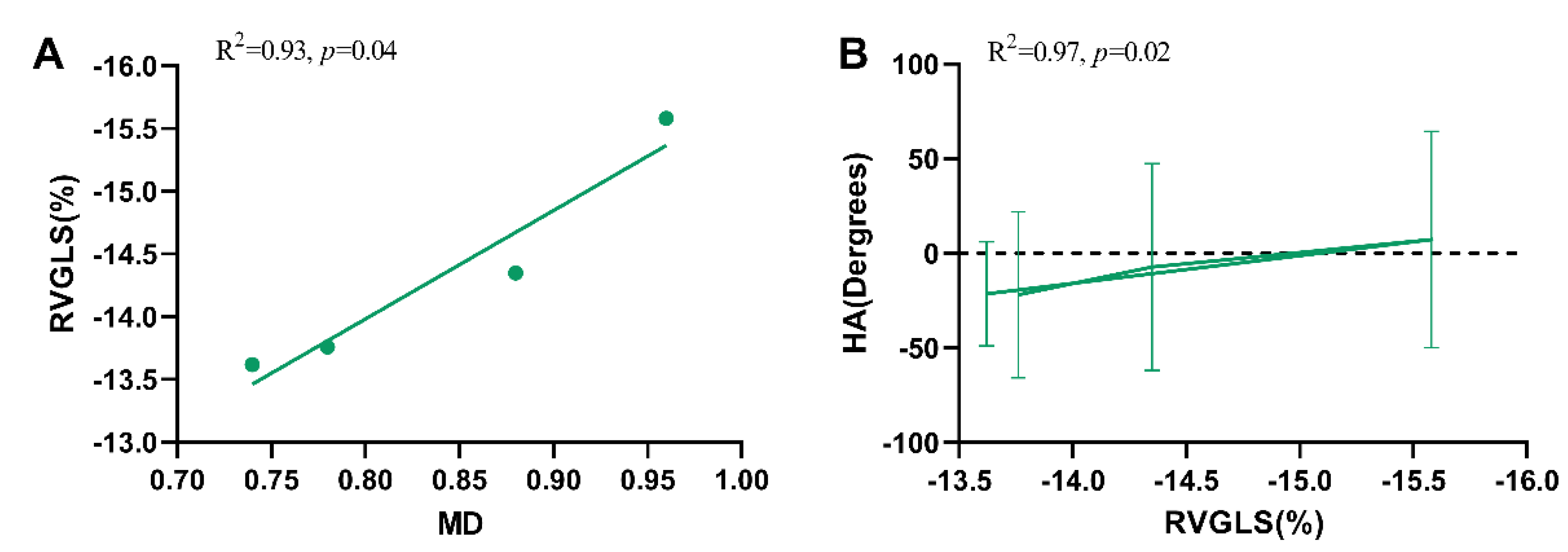Evaluation of Right Ventricular Function and Myocardial Microstructure in Fetal Hypoplastic Left Heart Syndrome
Abstract
1. Introduction
2. Materials and Method
2.1. Study Population
2.2. Fetal Echocardiography
2.3. Fetal Cardiac Function
2.4. Post-Mortem CMR Data Acquisition
2.5. Post Imaging Process
2.6. Statistical Analysis
3. Results
4. Discussion
5. Conclusions
Supplementary Materials
Author Contributions
Funding
Institutional Review Board Statement
Informed Consent Statement
Data Availability Statement
Conflicts of Interest
References
- Son, J.S.; James, A.; Fan, C.S.; Mertens, L.; McCrindle, B.W.; Manlhiot, C.; Friedberg, M.K. Prognostic Value of Serial Echocardiography in Hypoplastic Left Heart Syndrome. Circulation Cardiovasc. Imaging 2018, 11, e006983. [Google Scholar] [CrossRef] [PubMed]
- Lin, L.Q.; Conway, J.; Alvarez, S.; Goot, B.; Serrano-Lomelin, J.; Colen, T.; Tham, E.B.; Kutty, S.; Li, L.; Khoo, N.S. Reduced Right Ventricular Fractional Area Change, Strain, and Strain Rate before Bidirectional Cavopulmonary Anastomosis is Associated with Medium-Term Mortality for Children with Hypoplastic Left Heart Syndrome. J. Am. Soc. Echocardiogr. Off. Publ. Am. Soc. Echocardiogr. 2018, 31, 831–842. [Google Scholar] [CrossRef]
- Borrelli, N.; Di Salvo, G.; Sabatino, J.; Ibrahim, A.; Avesani, M.; Sirico, D.; Josen, M.; Penco, M.; Fraisse, A.; Michielon, G. Serial changes in longitudinal strain are associated with outcome in children with hypoplastic left heart syndrome. Int. J. Cardiol. 2020, 317, 56–62. [Google Scholar] [CrossRef] [PubMed]
- Zebhi, B.; Wiputra, H.; Howley, L.; Cuneo, B.; Park, D.; Hoffman, H.; Gilbert, L.; Yap, C.H.; Bark, D., Jr. Right ventricle in hypoplastic left heart syndrome exhibits altered hemodynamics in the human fetus. J. Biomech. 2020, 112, 110035. [Google Scholar] [CrossRef] [PubMed]
- Brooks, P.A.; Khoo, N.S.; Mackie, A.S.; Hornberger, L.K. Right ventricular function in fetal hypoplastic left heart syndrome. J. Am. Soc. Echocardiogr. Off. Publ. Am. Soc. Echocardiogr. 2012, 25, 1068–1074. [Google Scholar] [CrossRef] [PubMed]
- Zhang, J.; Zhou, Q.; Zhao, Y.; Peng, Q.; Gong, Z.; Long, X. Evaluation of right ventricular function in fetal hypoplastic left heart syndrome using spatio-temporal image correlation (STIC). Cardiovasc. Ultrasound 2016, 14, 12. [Google Scholar] [CrossRef]
- Nawaytou, H.M.; Peyvandi, S.; Brook, M.M.; Silverman, N.; Moon-Grady, A.J. Right Ventricular Systolic-to-Diastolic Time Index: Hypoplastic Left Heart Fetuses Differ Significantly from Normal Fetuses. J. Am. Soc. Echocardiogr. Off. Publ. Am. Soc. Echocardiogr. 2016, 29, 143–149. [Google Scholar] [CrossRef][Green Version]
- Graupner, O.; Enzensberger, C.; Wieg, L.; Willruth, A.; Steinhard, J.; Gembruch, U.; Doelle, A.; Bahlmann, F.; Kawecki, A.; Degenhardt, J.; et al. Evaluation of right ventricular function in fetal hypoplastic left heart syndrome by color tissue Doppler imaging. Ultrasound Obstet. Gynecol. Off. J. Int. Soc. Ultrasound Obstet. Gynecol. 2016, 47, 732–738. [Google Scholar] [CrossRef]
- Kovács, A.; Lakatos, B.; Tokodi, M.; Merkely, B. Right ventricular mechanical pattern in health and disease: Beyond longitudinal shortening. Heart Fail. Rev. 2019, 24, 511–520. [Google Scholar] [CrossRef] [PubMed]
- Bohlmeyer, T.J.; Helmke, S.; Ge, S.; Lynch, J.; Brodsky, G.; Sederberg, J.H.; Robertson, A.D.; Minobe, W.; Bristow, M.R.; Perryman, M.B. Hypoplastic left heart syndrome myocytes are differentiated but possess a unique phenotype. Cardiovasc. Pathol. Off. J. Soc. Cardiovasc. Pathol. 2003, 12, 23–31. [Google Scholar] [CrossRef]
- Salih, C.; Sheppard, M.N.; Ho, S.Y. Morphometry of coronary capillaries in hypoplastic left heart syndrome. Ann. Thorac. Surg. 2004, 77, 903–907. [Google Scholar] [CrossRef] [PubMed]
- Davies, B.; d’Udekem, Y.; Ukoumunne, O.C.; Algar, E.M.; Newgreen, D.F.; Brizard, C.P. Differences in extra-cellular matrix and myocyte homeostasis between the neonatal right ventricle in hypoplastic left heart syndrome and truncus arteriosus. Eur. J. Cardio-Thorac. Surg. 2008, 34, 738–744. [Google Scholar] [CrossRef] [PubMed]
- Salih, C.; McCarthy, K.P.; Ho, S.Y. The fibrous matrix of ventricular myocardium in hypoplastic left heart syndrome: A quantitative and qualitative analysis. Ann. Thorac. Surg. 2004, 77, 36–40. [Google Scholar] [CrossRef]
- Jiang, Y.; Xu, Y.; Tang, J.; Xia, H. Assessment of Structural and Functional Abnormalities of the Myocardium and the Ascending Aorta in Fetus with Hypoplastic Left Heart Syndrome. BioMed Res. Int. 2016, 2016, 2616729. [Google Scholar] [CrossRef]
- Abdullah, O.M.; Seidel, T.; Dahl, M.; Gomez, A.D.; Yiep, G.; Cortino, J.; Sachse, F.B.; Albertine, K.H.; Hsu, E.W. Diffusion tensor imaging and histology of developing hearts. NMR Biomed. 2016, 29, 1338–1349. [Google Scholar] [CrossRef]
- Khalique, Z.; Ferreira, P.F.; Scott, A.D.; Nielles-Vallespin, S.; Firmin, D.N.; Pennell, D.J. Diffusion Tensor Cardiovascular Magnetic Resonance Imaging: A Clinical Perspective. JACC. Cardiovasc. Imaging 2020, 13, 1235–1255. [Google Scholar] [CrossRef]
- Nishitani, S.; Torii, N.; Imai, H.; Haraguchi, R.; Yamada, S.; Takakuwa, T. Development of Helical Myofiber Tracts in the Human Fetal Heart: Analysis of Myocardial Fiber Formation in the Left Ventricle From the Late Human Embryonic Period Using Diffusion Tensor Magnetic Resonance Imaging. J. Am. Heart Assoc. 2020, 9, e016422. [Google Scholar] [CrossRef] [PubMed]
- Khalique, Z.; Ferreira, P.F.; Scott, A.D.; Nielles-Vallespin, S.; Martinez-Naharro, A.; Fontana, M.; Hawkins, P.; Firmin, D.N.; Pennell, D.J. Diffusion Tensor Cardiovascular Magnetic Resonance in Cardiac Amyloidosis. Circ. Cardiovasc. Imaging 2020, 13, e009901. [Google Scholar] [CrossRef] [PubMed]
- Helm, P.A.; Tseng, H.J.; Younes, L.; McVeigh, E.R.; Winslow, R.L. Ex vivo 3D diffusion tensor imaging and quantification of cardiac laminar structure. Magn. Reson. Med. 2005, 54, 850–859. [Google Scholar] [CrossRef]
- Alphonso, N.; Angelini, A.; Barron, D.J.; Bellsham-Revell, H.; Blom, N.A.; Brown, K.; Davis, D.; Duncan, D.; Fedrigo, M.; Galletti, L.; et al. Guidelines for the management of neonates and infants with hypoplastic left heart syndrome: The European Association for Cardio-Thoracic Surgery (EACTS) and the Association for European Paediatric and Congenital Cardiology (AEPC) Hypoplastic Left Heart Syndrome Guidelines Task Force. Eur. J. Cardio-Thorac. Surg. Off. J. Eur. Assoc. Cardio-Thorac. Surg. 2020, 58, 416–499. [Google Scholar]
- Schneider, C.; McCrindle, B.W.; Carvalho, J.S.; Hornberger, L.K.; McCarthy, K.P.; Daubeney, P.E. Development of Z-scores for fetal cardiac dimensions from echocardiography. Ultrasound Obstet. Gynecol. Off. J. Int. Soc. Ultrasound Obstet. Gynecol. 2005, 26, 599–605. [Google Scholar] [CrossRef]
- The International Society of Ultrasound in Obstetrics and Gynecology; Carvalho, J.S.; Allan, L.D.; Chaoui, R.; Copel, J.A.; DeVore, G.R.; Hecher, K.; Lee, W.; Munoz, H.; Paladini, D.; et al. ISUOG Practice Guidelines (updated): Sonographic screening examination of the fetal heart. Ultrasound Obstet. Gynecol. Off. J. Int. Soc. Ultrasound Obstet. Gynecol. 2013, 41, 348–359. [Google Scholar] [CrossRef]
- Ferreira, P.F.; Kilner, P.J.; McGill, L.A.; Nielles-Vallespin, S.; Scott, A.D.; Ho, S.Y.; McCarthy, K.P.; Haba, M.M.; Ismail, T.F.; Pennell, D.J.; et al. In vivo cardiovascular magnetic resonance diffusion tensor imaging shows evidence of abnormal myocardial laminar orientations and mobility in hypertrophic cardiomyopathy. J. Cardiovasc. Magn. Reson. 2014, 16, 87. [Google Scholar] [CrossRef]
- Cerqueira, M.D.; Weissman, N.J.; Dilsizian, V.; Jacobs, A.K.; Kaul, S.; Laskey, W.K.; Pennell, D.J.; Rumberger, J.A.; Ryan, T.; Verani, M.S. Standardized myocardial segmentation and nomenclature for tomographic imaging of the heart. A statement for healthcare professionals from the Cardiac Imaging Committee of the Council on Clinical Cardiology of the American Heart Association. Circulation 2002, 105, 539–542. [Google Scholar] [PubMed]
- Buckberg, G.D.; Hoffman, J.I.; Coghlan, H.C.; Nanda, N.C. Ventricular structure-function relations in health and disease: Part I. The normal heart. Eur. J. Cardio-Thorac. Surg. Off. J. Eur. Assoc. Cardio-Thorac. Surg. 2015, 47, 587–601. [Google Scholar] [CrossRef] [PubMed]
- Blessberger, H.; Binder, T. NON-invasive imaging: Two dimensional speckle tracking echocardiography: Basic principles. Heart 2010, 96, 716–722. [Google Scholar] [CrossRef]
- Natarajan, S.; Szwast, A.; Tian, Z.; McCann, M.; Soffer, D.; Rychik, J. Right ventricular mechanics in the fetus with hypoplastic left heart syndrome. J. Am. Soc. Echocardiogr. Off. Publ. Am. Soc. Echocardiogr. 2013, 26, 515–520. [Google Scholar] [CrossRef]
- Graupner, O.; Enzensberger, C.; Wieg, L.; Degenhardt, J.; Wolter, A.; Khalil, M.; Schranz, D.; Yerebakan, C.; Doelle, A.; Herrmann, J.; et al. Endocardial Fibroelastosis of the Left Ventricle Affects Right Ventricular Performance in Fetuses with Hypoplastic Left Heart Syndrome: A Prospective Study Using M-Mode, PW- and Tissue Doppler Techniques. Ultraschall Med. 2018, 39, 413–421. [Google Scholar] [CrossRef]
- Walsh, M.A.; McCrindle, B.W.; Dipchand, A.; Manlhiot, C.; Hickey, E.; Caldarone, C.A.; Van Arsdell, G.S.; Schwartz, S.M. Left ventricular morphology influences mortality after the Norwood operation. Heart 2009, 95, 1238–1244. [Google Scholar] [CrossRef]
- Haberer, K.; Fruitman, D.; Power, A.; Hornberger, L.K.; Eckersley, L. Fetal echocardiographic predictors of biventricular circulation in hypoplastic left heart complex. Ultrasound Obstet. Gynecol. Off. J. Int. Soc. Ultrasound Obstet. Gynecol. 2021, 58, 405–410. [Google Scholar] [CrossRef] [PubMed]
- Nguyen, C.; Fan, Z.; Xie, Y.; Dawkins, J.; Tseliou, E.; Bi, X.; Sharif, B.; Dharmakumar, R.; Marbán, E.; Li, D. In vivo contrast free chronic myocardial infarction characterization using diffusion-weighted cardiovascular magnetic resonance. J. Cardiovasc. Magn. Reson. Off. J. Soc. Cardiovasc. Magn. Reson. 2014, 16, 68. [Google Scholar] [CrossRef] [PubMed]
- von Deuster, C.; Sammut, E.; Asner, L.; Nordsletten, D.; Lamata, P.; Stoeck, C.T.; Kozerke, S.; Razavi, R. Studying Dynamic Myofiber Aggregate Reorientation in Dilated Cardiomyopathy Using In Vivo Magnetic Resonance Diffusion Tensor Imaging. Circulation Cardiovasc. Imaging 2016, 9, e005018. [Google Scholar] [CrossRef] [PubMed]
- Ariga, R.; Tunnicliffe, E.M.; Manohar, S.G.; Mahmod, M.; Raman, B.; Piechnik, S.K.; Francis, J.M.; Robson, M.D.; Neubauer, S.; Watkins, H. Identification of Myocardial Disarray in Patients With Hypertrophic Cardiomyopathy and Ventricular Arrhythmias. J. Am. Coll. Cardiol. 2019, 73, 2493–2502. [Google Scholar] [CrossRef] [PubMed]
- Hristov, N.; Liakopoulos, O.J.; Buckberg, G.D.; Trummer, G. Septal structure and function relationships parallel the left ventricular free wall ascending and descending segments of the helical heart. Eur. J. Cardio-Thorac. Surg. Off. J. Eur. Assoc. Cardio-Thorac. Surg. 2006, 29 (Suppl. 1), S115–S125. [Google Scholar] [CrossRef] [PubMed]
- Saleh, S.; Liakopoulos, O.J.; Buckberg, G.D. The septal motor of biventricular function. Eur. J. Cardio-Thorac. Surg. Off. J. Eur. Assoc. Cardio-Thorac. Surg. 2006, 29 (Suppl. 1), S126–S138. [Google Scholar] [CrossRef]
- Tous, C.; Gentles, T.L.; Young, A.A.; Pontré, B.P. Ex vivo cardiovascular magnetic resonance diffusion weighted imaging in congenital heart disease, an insight into the microstructures of tetralogy of Fallot, biventricular and univentricular systemic right ventricle. J. Cardiovasc. Magn. Reson. 2020, 22, 69. [Google Scholar] [CrossRef]






| Variable | Control Group (n = 42) | HLHS Group (n = 42) | p Vaule |
|---|---|---|---|
| Maternal characteristic | |||
| Age (years) | 30.00 ± 5.07 | 29.45 ± 5.46 | 0.40 |
| BMI (kg/m2) | 24.67 ± 3.34 | 23.40 ± 3.01 | 0.15 |
| Gestational Age (weeks) | 24.67 ± 3.34 | 24.49 ± 3.88 | 0.31 |
| Obstetric history | |||
| Gravidity | 2(1–3) | 3(2–5) | <0.01 |
| Parity | 1(0–2) | 1(0–1) | 0.05 |
| Abortion | 0(0–2) | 1(0–2) | 0.36 |
| Anatomical variants | |||
| Mitral atresia (MA)/aortic atresia (AA) | 11(26.20%) | ||
| Mitral stenosis (MS)/AA | 6(14.29%) | ||
| MS/aortic stenosis (AS) | 10(23.81%) | ||
| Hypoplastic left heart complex (HLHC) | 15(35.71%) | ||
| LV morphology | |||
| silt-like | 15(35.71%) | ||
| miniature | 25(59.52%) | ||
| Dilation | 2(4.76%) |
| Variable | Control Group | HLHS Group | p-Value |
|---|---|---|---|
| (n = 42) | (n = 42) | ||
| Morphometric measurements | |||
| RVGSI | 0.58 ± 0.08 | 0.71 ± 0.15 | <0.01 |
| LVGSI | 0.49 ± 0.05 | 0.52 ± 0.15 | 0.02 |
| LVEDD (cm) | 0.95 (0.83 to 1.02) | 0.56 (0.35 to 0.72) | <0.001 |
| LVEDD z-score | 0.42 (−0.13 to 0.83) | −3.51 (−5.58 to −2.1) | <0.001 |
| LVEDL (cm) | 1.92 (1.83 to 2.04) | 1.04 (0.69 to 1.4) | <0.001 |
| LVEDL z-score | 0.06 (−0.24 to 0.87) | −4.34 (−6.5 to −2.88) | <0.001 |
| RVEDD (cm) | 0.97 (0.9 to 1.05) | 1.10 (0.92–1.19) | 0.02 |
| RVEDD z-score | 0.04 (−0.27 to 0.51) | 0.66 (−0.34 to 1.75) | 0.04 |
| RVEDL (cm) | 1.72 (1.57 to 1.83) | 1.61 (1.34 to 1.74) | 0.14 |
| RVEDL z-score | −0.03 (−0.58 to 0.24) | −0.83 (−1.64 to −0.23) | <0.01 |
| FO (cm) | 0.48 ± 0.09 | 0.41 ± 0.15 | 0.03 |
| PV z-score | 0.19 (−0.47 to 0.97) | 0.41 (−0.47 to 1.09) | 0.69 |
| Main PA z-score | 0.65 (0.1 to 1.06) | 0.89 (0.26 to 1.34) | 0.12 |
| LPA z-score | 0.29 (−0.08 to 0.61) | −0.35 (−1.07 to 0.05) | <0.001 |
| RPA z-score | 0.12 (−0.39 to 0.57) | −0.56 (−1.21 to −0.06) | <0.001 |
| DA z-score | −0.12 (−0.41 to −0.12) | 0.62 (−0.29 to 1.04) | <0.001 |
| AAo z-score | 0.09 (−0.28 to 0.43) | −3.21 (−4.89 to −2.41) | <0.001 |
| AV z-score | 0.08 (−0.38 to 0.60) | −3.1 (−4.38 to −2.18) | <0.001 |
| Hemodynamic Measurements | |||
| Pulmonary artery | |||
| Peak systolic velocity (cm/s) | 70.3 ± 17.78 | 77.24 ± 14.96 | 0.14 |
| Ductus arteriosus | |||
| Peak systolic velocity (cm/s) | 93.21 ± 22.99 | 96.51 ± 20.44 | 0.84 |
| Ascending aorta | |||
| Peak systolic velocity (cm/s) | 94.43 ± 10.23 | 111.15 ± 49.45 | 0.04 |
| FHR (bmp) | 148.77 ± 7.07 | 147.37 ± 6.05 | 0.18 |
| Variable | Control Group (n = 42) | HLHS Group (n = 42) | p Value |
|---|---|---|---|
| Systolic Function | |||
| RVGLS (%) | −21.60 (−22.32 to −19.99) | −15.58 (−18.33 to −13.87) | <0.001 |
| RVGLVs (cm/s) | −1.75 (−2.94 to −1.58) | −1.50 (−2.20 to −1.00) | 0.02 |
| RVGLSRs (s−1) | −1.95 (−2.45 to −1.65) | −1.40 (−1.68 to −1.20) | <0.01 |
| Diastolic Function | |||
| RVGLDd (mm) | 1.90 (1.42 to 2.68) | 1.20 (0.89 to 1.60) | <0.001 |
| RVGLVd (cm/s) | 1.60 (1.28 to 2.45) | 0.95 (0.70 to 1.50) | <0.001 |
| RVGLSRd (s−1) | 2.05 (1.40 to 2.43) | 1.80 (1.25 to 2.15) | 0.10 |
| Variable | RVGLS | 95% CI | |
|---|---|---|---|
| β | p Value | ||
| GA (weeks) | 0.03 | 0.85 | 0.19–0.85 |
| RVEDD z-score | −0.26 | 0.12 | −1.55–0.19 |
| RVEDL z-score | 0.15 | 0.38 | −0.53–1.34 |
| RVEDD/LVEDD | −0.48 * | 0.01 | −1.81 to −0.25 |
| RVGSI | −0.24 | 0.14 | −12.14 to 1.81 |
| LVEDD z-score | 0.37 * | 0.03 | 0.06–0.92 |
| LVEDL z-score | 0.32 | 0.06 | −0.02–0.75 |
| LVGSI | 0.079 | 0.64 | −0.58–9.33 |
| FO (cm) | −0.14 | 0.43 | −9.69–4.18 |
| LPA z-score | −0.21 | 0.21 | −2.33–0.52 |
| RPA z-score | −0.20 | 0.24 | −2.47–0.65 |
| DA z-score | −0.13 | 0.45 | −1.51–0.68 |
| AAo z-score | 0.39 * | 0.02 | 0.05–0.69 |
| AV z-score | 0.36 | 0.06 | −0.02–0.89 |
| RVGLS | |||
|---|---|---|---|
| Variable | β | p | 95% CI |
| RVEDD/LVEDD | 0.06 | 0.90 | |
| AAo z-score | 0.20 | 0.34 | |
| LVEDD z-score * | 0.48 | 0.02 | 0.08–1.01 |
| Variable | Control (n = 3) | HLHS (n = 3) | HLHS (Dilation) | p-Value |
|---|---|---|---|---|
| FA | 0.18 ± 0.01 | 0.21 ± 0.02 | 0.3 ± 0.04 | <0.01 |
| MD (×10−3, mm2·s−1) | 1.3 ± 0.15 | 0.88 ± 0.13 | 0.74 ± 0.06 | <0.001 |
| Variable | Control (n = 3) | HLHS (n = 3) | HLHS (Dilation) | p-Value |
|---|---|---|---|---|
| Basal | ||||
| lateral | −6.85 ± 31.34 | −7.31 ± 51.91 | −4.77 ± 35.36 | 0.25 |
| anteroseptal | 12.89 ± 36.06 | 1.2 ± 54.31 | −21.43 ± 27.59 | <0.001 |
| inferoseptal | −21.75 ± 31.63 | 2.54 ± 53.46 | 29.87 ± 34.93 | <0.001 |
| Middle | ||||
| lateral | −9.38 ± 28.18 | 1.71 ± 50.92 | −6.07 ± 34.07 | <0.001 |
| anteroseptal | 23.29 ± 36.59 | −1.54 ± 41.38 | −24.96 ± 25.05 | <0.001 |
| inferoseptal | −14.37 ± 41.38 | 1.73 ± 61.31 | −14.94 ± 45.58 | <0.001 |
| Apical | ||||
| lateral | −11.16 ± 29.86 | −6.19 ± 46.61 | −7.53 ± 36.17 | <0.001 |
| anteroseptal | 27.19 ± 33.72 | −19.04 ± 23.58 | ||
| inferoseptal | 17.06 ± 39.39 | −32.85 ± 39.29 |
Publisher’s Note: MDPI stays neutral with regard to jurisdictional claims in published maps and institutional affiliations. |
© 2022 by the authors. Licensee MDPI, Basel, Switzerland. This article is an open access article distributed under the terms and conditions of the Creative Commons Attribution (CC BY) license (https://creativecommons.org/licenses/by/4.0/).
Share and Cite
Ma, J.; Yuan, Y.; Zhang, L.; Chen, S.; Cao, H.; Hong, L.; Liu, J.; Song, X.; Shi, J.; Zhang, Y.; et al. Evaluation of Right Ventricular Function and Myocardial Microstructure in Fetal Hypoplastic Left Heart Syndrome. J. Clin. Med. 2022, 11, 4456. https://doi.org/10.3390/jcm11154456
Ma J, Yuan Y, Zhang L, Chen S, Cao H, Hong L, Liu J, Song X, Shi J, Zhang Y, et al. Evaluation of Right Ventricular Function and Myocardial Microstructure in Fetal Hypoplastic Left Heart Syndrome. Journal of Clinical Medicine. 2022; 11(15):4456. https://doi.org/10.3390/jcm11154456
Chicago/Turabian StyleMa, Jing, Yaping Yuan, Li Zhang, Shizhen Chen, Haiyan Cao, Liu Hong, Juanjuan Liu, Xiaoyan Song, Jiawei Shi, Yi Zhang, and et al. 2022. "Evaluation of Right Ventricular Function and Myocardial Microstructure in Fetal Hypoplastic Left Heart Syndrome" Journal of Clinical Medicine 11, no. 15: 4456. https://doi.org/10.3390/jcm11154456
APA StyleMa, J., Yuan, Y., Zhang, L., Chen, S., Cao, H., Hong, L., Liu, J., Song, X., Shi, J., Zhang, Y., Cui, L., Zhou, X., & Xie, M. (2022). Evaluation of Right Ventricular Function and Myocardial Microstructure in Fetal Hypoplastic Left Heart Syndrome. Journal of Clinical Medicine, 11(15), 4456. https://doi.org/10.3390/jcm11154456







